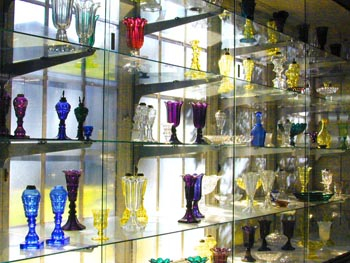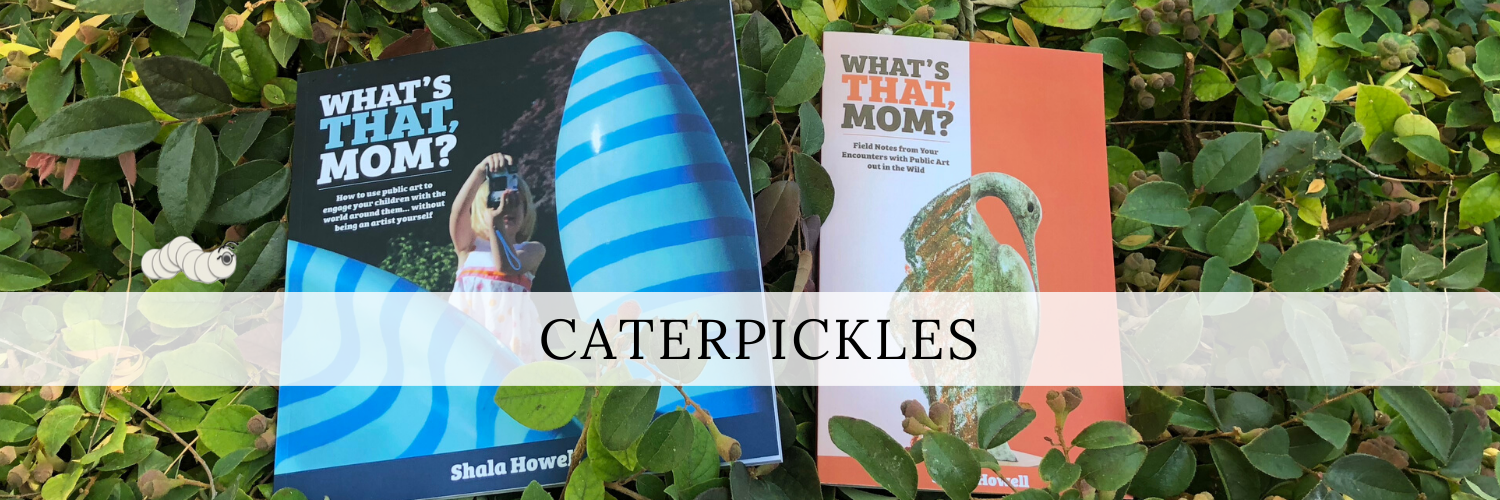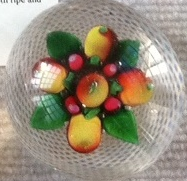In which we visit the Sandwich Glass Museum in Sandwich, MA

Wall of glass in the museum’s permanent collection (Image Credit: Sandwich Glass Museum)We visited the Sandwich Glass Museum this past spring, when I was experiencing a bout of severe Cape deprivation, and my daughter and husband agreed that I needed emergency treatment.
Last spring, when I was experiencing an extreme case of Cape deprivation, my husband and daughter very kindly agreed to come with me on a day-trip to the Cape. We decided to visit the Sandwich Glass Museum because it was one of those things that we had wanted to see on our vacation in the Cape the previous summer, but which we had somehow never quite gotten around to. Funny how a live glass-blowing demonstration sounds more appealing on a drizzly 42 degree March day than it does on a sunny 95 degree August one.
When we arrived, we had about twenty minutes to wait until the next demonstration, so we tooled around the museum’s permanent collection, marveling at the rich colors of the red, purple and blue vases, and carefully stepping around the radioactive yellow ones. (For a time, glass makers used uranium to turn glass a particular shade of canary yellow. The Sandwich Museum has a few of these radioactive pieces on display, tucked safely behind thick glass and lead.)
We also stopped by Hannah Burgess’ eternal dinner party, and watched a short film on the history of glass-making in Sandwich.
But the highlight of our trip was clearly the glass-blowing demonstration. The show started off with the traditional method, in which the glass blower pulls glowing lumps of superheated glass of a wall-sized kiln of fire with an iron rod and coaxes it into shape before the glass cools and cracks.
On this particular day, the glass blower was attempting to create an image of the Virgin Mary for a nativity scene she was preparing for the Second Annual Glassblowers Christmas this December. She pinched and pulled the molten glass to create the basic shape of Mary’s head and body, returned it to the kiln to reheat it, and pulled it out again, this time adding a bit of color to the body, before tucking it into the kiln to reheat, all the time talking to us about the Christmas show, how she was trained as a glass maker, and what she was doing to the glass itself.
For 15 minutes the dance continued, heat, shape, color, reheat, twirl, until the figure of Mary had finally, improbably, emerged, complete except for her veil. The veil was the trickiest part, our glassblower explained. It had to be added on as a separate piece of glass and the weight of the glass in the veil had a tendency to squish Mary’s head. She showed us the previous day’s Mary. Its head was only vaguely potato-shaped and so would do, which is why she had kept it, but she knew she could do better.
Sadly, the squishing again proved to be too much, and with a ruthlessness a bit shocking to those of us who had become attached to this glass blown miracle, she broke the cooling Mary off into a wooden barrel. The great thing about working with glass, she explained, is that once it’s cooled, you can simply tip your failures back into the kiln and try again.
And then she wheeled out the glass press. Figuratively, of course. The press is too heavy to move.
The invention of the glass press revolutionized glass making in America by replacing the extremely complex glass-blowing process we had just seen with something even a child can do. To demonstrate this, she recruited a four-year-old from the audience.
Pulling a glowing lump of glass from the kiln with her trusty iron rod, she positioned the glass in the press and showed my daughter which lever to pull. My daughter pulled, the glass was pressed and just like that a plate was born. The whole thing took about thirty seconds.
Just long enough for the rejected Mary to cool and pop.
What’s there:
- Live glass-blowing demonstration
- A permanent exhibit describing the history of glass-making in Sandwich, MA (Includes 6000 pieces of glass made locally)
- Rotating contemporary glass exhibits
- A short film on the history of glass-making in Sandwich
- Gift shop full of rather extraordinary glass art
When to go
The Sandwich Glass Museum is open from February to December. Hours vary based on the season (the Museum is open daily from April to December, but only four days a week in February and March).
When you do go, give yourself at least an hour and a half to see everything. Glass blowing demonstrations are held every hour on the hour while the museum is open.
So would we go again?
Yes. We’re planning to return for the Second Annual Glass Blowers Christmas to see how the nativity scene turned out.
Logistical Stuff
| What | Sandwich Glass Museum |
| Address | 129 Main Street Sandwich,MA 02563 |
| Phone | 508-888-0251 |
| Website | www.sandwichglassmuseum.org |
| Sandwich Glass Museum | |
| eliane.thomas@sandwichglassmuseum.org | |
| Cost | $5.00 for adults, $1.25 for kids 6-14. Kids 5 and under are free |
| Hours | April 1 – December 31: Open daily 9:30 am – 5:00 pm February – March: Wed-Sun 9:30-4:00. |
Related Caterpickles:





What are you thinking?